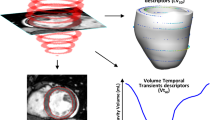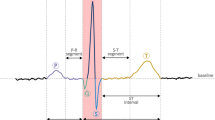Abstract
Early detection of potential hazards in the fetal physiological state during pregnancy and childbirth is very important. Noninvasive fetal electrocardiogram (FECG) can be extracted from the maternal abdominal signal. However, due to the interference of maternal electrocardiogram and other noises, the task of extraction is challenging. This paper introduces a novel single-lead noninvasive fetal electrocardiogram extraction method based on the technique of clustering and PCA. The method is divided into four steps: (1) pre-preprocessing; (2) fetal QRS complexes and maternal QRS complexes detection based on k-means clustering algorithm with the feature of max-min pairs; (3) FQRS correction step is to improve the performance of step two; (4) template subtraction based on PCA is introduced to extract FECG waveform. To verify the performance of the proposed algorithm, two clinical open-access databases are used to check the performance of FQRS detection. As a result, the method proposed shows the average PPV of 95.35%, Se of 96.23%, and F1-measure of 95.78%. Furthermore, the robustness test is carried out on an artificial database which proves that the algorithm has certain robustness in various noise environments. Therefore, this method is feasible and reliable to detect fetal heart rate and extract FECG.

Early detection of potential hazards in the fetal physiological state during pregnancy and childbirth is very important. Noninvasive fetal electrocardiogram (FECG) can be extracted from maternal abdominal signal. However, due to the interference of maternal electrocardiogram and other noises, the task of extraction is challenging. This paper introduces a novel single-lead noninvasive fetal electrocardiogram extraction method based on the technique of clustering and PCA. The method is divided into four steps: (1) pre-preprocessing; (2) fetal QRS complexes and maternal QRS complexes detection based on k-means clustering algorithm with the feature of max-min pairs; (3) FQRS correction step is to improve the performance of step two; (4) template subtraction based on PCA is introduced to extract FECG waveform. To verify the performance of algorithm, two clinical open-access databases are used to check the performance of FQRS detection. As a result, the method proposed shows the average PPV of 95.35%, Se of 96.23%, and F1-measure of 95.78%. Furthermore, the robustness test is carried out on an artificial database which proves that the algorithm has certain robustness in various noise environments. Therefore, this method is feasible and reliable to detect fetal heart rate and extract FECG.









Similar content being viewed by others
References
Bhutta ZA, Yakoob MY, Lawn JE, Rizvi A, Friberg IK, Weissman E, Buchmann E, Goldenberg RL, Lancet's Stillbirths Series steering committee (2011) Stillbirths: what difference can we make and at what cost? Lancet 377(9776):1523–1538
Sameni R, Clifford GD (2010) A review of fetal ECG signal processing issues and promising directions. Open Pacing Electrophysiol Ther J 3(1):4–20
De Lathauwer L, De Moor B, Vandewalle J (2000) Fetal electrocardiogram extraction by blind source subspace separation. IEEE Trans Biomed Eng 47(5):567–572
Clifford GD, Silva I, Behar J, Moody GB (2014) Non-invasive fetal ECG analysis. Physiol Meas 35(8):1521–1536
Varanini M, et al.(2014) A multi-step approach for non-invasive fetal ECG analysis. Computing in Cardiology Conference IEEE
Sameni R, Jutten C, Shamsollahi MB (2008) Multichannel electrocardiogram decomposition using periodic component analysis. IEEE Trans Biomed Eng 55(8):1935–1940
Widrow B (1975) Adaptive noise cancelling: principles and applications. Proc IEEE 63(12):1692–1716
Nannan Z et al (2017) A novel technique for fetal ECG extraction using single-channel abdominal recording. Sensors 17.3:457
Panigrahy D, Sahu PK (2017) Extraction of fetal ECG signal by an improved method using extended Kalman smoother framework from single channel abdominal ECG signal. Australas Phys Eng Sci Med 40(1):191–207
Desai KD, and Sankhe MS (2012) A real-time fetal ECG feature extraction using multiscale discrete wavelet transform. Biomedical Engineering and Informatics (BMEI), 5th International Conference on IEEE
Hasan MA, Reaz MBI, and Ibrahimy MI (2011) Fetal electrocardiogram extraction and R-peak detection for fetal heart rate monitoring using artificial neural network and correlation. The 2011 International Joint Conference on Neural Networks
Martens SMM et al (2007) A robust fetal ECG detection method for abdominal recordings. Physiol Meas 28(4):373–388
Kanjilal PP, Palit S, Saha G (1997) Fetal ECG extraction from single-channel maternal ECG using singular value decomposition. IEEE Trans Biomed Eng 44(1):51–59
Petrenas A et al (2012) An Echo state neural network for QRST cancellation during atrial fibrillation. IEEE Trans Biomed Eng 59(10):2950–2957
Zhidong Z et al (2017) Single-lead fetal ECG extraction based on a parallel marginalized particle filter. Sensors 17.6:1456
Member S et al (1985) A real-time QRS detection algorithm. IEEE Trans Biomed Eng 32(3):230–236
Agostinelli A et al (2017) Noninvasive fetal electrocardiography part I: pan-Tompkins’ algorithm adaptation to fetal R-peak identification. Open Biomed Eng J 11(1):17–24
Goldberger AL, Amaral LA, Glass L, Hausdorff JM, Ivanov PC, Mark RG, Mietus JE, Moody GB, Peng CK, Stanley HE (2000) PhysioBank, PhysioToolkit, and PhysioNet: components of a new research resource for complex physiologic signals. Circulation 101(23):e215–e220
Matonia A, Jezewski J, Kupka T, Horoba K, Wrobel J, Gacek A (2006) The influence of coincidence of fetal and maternal QRS complexes on fetal heart rate reliability. Med Biol EngComput 44(5):393–403
Andreotti F et al (2016) An open-source framework for stress-testing non-invasive foetal ECG extraction algorithms. Physiol Meas 37(5):627–648
Behar J, Andreotti F, Zaunseder S, Li Q, Oster J, Clifford GD (2014) An ECG simulator for generating maternal-foetal activity mixtures on abdominal ECG recordings. Physiol Meas 35(8):1537–1550
Wong JA, Hartiganm A (1979) Algorithm AS 136: a k-means clustering algorithm. J R Stat Soc Ser C Appl Stat 28.1:100–108
Karvounis EC, Tsipouras MG, Fotiadis DI (2009) Detection of fetal heart rate through 3-D phase space analysis from multivariate abdominal recordings. IEEE Trans Biomed Eng 56.5:1394–1406
Guyton A, Hall J (2012) Textbook of medical physiology. Q J Exp Physiol Cognate Med Sci 134.12:1089
ANSI/AAMI/ISO EC57 (1998/(R)2008) Testing and reporting performance results of cardiac rhythm and ST- segment measurement algorithms
Marchon Niyan, and Naik G (2015) Electrode positioning for monitoring Fetal ECG: a review. 2015 International Conference on Information Processing (ICIP) IEEE
Behar J, Johnson A, Clifford GD, Oster J (2014) A comparison of single channel fetal ECG extraction methods. Ann Biomed Eng 42(6):1340–1353
Lee Jun Seong, et al (2018) Fetal QRS detection based on convolutional neural networks in noninvasive fetal electrocardiogram.. 2018 4th International Conference on Frontiers of Signal Processing (ICFSP) IEEE
Andreotti F, Riedl M, Himmelsbach T, Wedekind D, Wessel N, Stepan H, Schmieder C, Jank A, Malberg H, Zaunseder S (2014) Robust fetal ECG extraction and detection from abdominal leads. Physiol Meas 35(8):1551–1567
Funding
This work was supported by the National Natural Science Foundation of China (No.61571628).
Author information
Authors and Affiliations
Corresponding author
Ethics declarations
Conflict of interest
The authors declare that they have no conflict of interest.
Additional information
Publisher’s note
Springer Nature remains neutral with regard to jurisdictional claims in published maps and institutional affiliations.
Rights and permissions
About this article
Cite this article
Zhang, Y., Yu, S. Single-lead noninvasive fetal ECG extraction by means of combining clustering and principal components analysis. Med Biol Eng Comput 58, 419–432 (2020). https://doi.org/10.1007/s11517-019-02087-7
Received:
Accepted:
Published:
Issue Date:
DOI: https://doi.org/10.1007/s11517-019-02087-7




